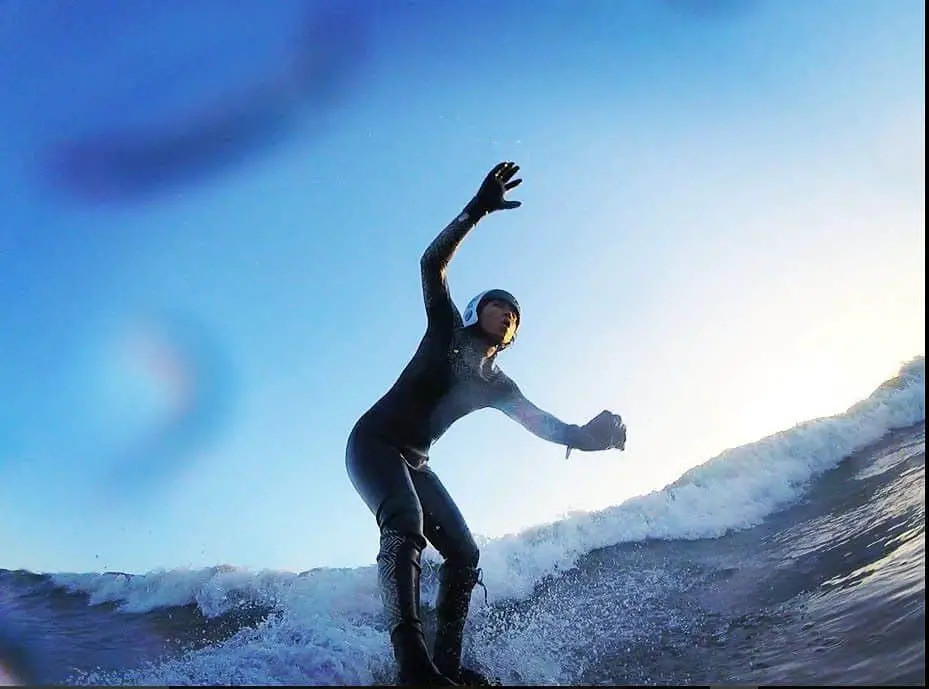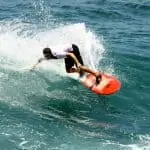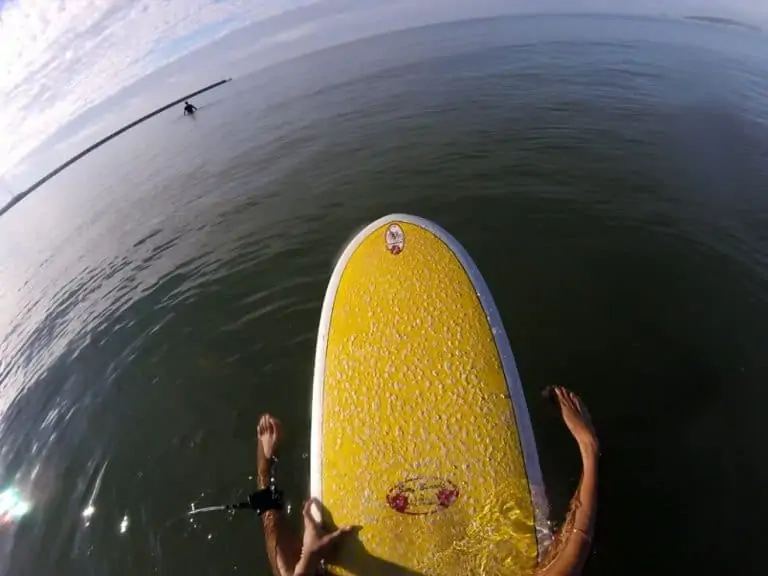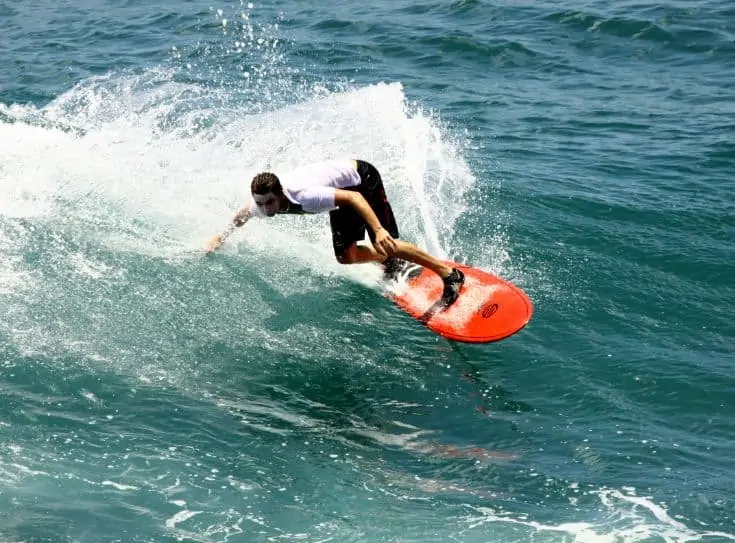First Surf Lesson? Here’s EXACTLY What to Expect!
Everyone loves surfing (at least, everyone I know!) However, not all of us were born by the ocean and had the chance to learn how to surf as kids.
Fortunately, it’s getting easier and easier for most people to travel to beach destinations. This means that if you are not a surfer now, there’s no reason why you won’t become one in the future.
Surfing can be an excellent part of a healthy and active lifestyle, so much so that some doctors nowadays are even prescribing it to patients to help them to improve their mental wellbeing. But before you can experience what the pros call a ‘surf stoke’, you will have to learn the ropes.
If you’ve decided to take up surfing, you might have made the safe and right decision to sign up for surf classes. If you’re feeling nervous about it, this article will help you arrive prepared for your first lesson.
How do I prepare for my first surfing lesson?
Don’t worry, your lesson will actually start at the beach and you don’t have to train excessively or do anything unusual before time. However, there are 3 areas you can work on before starting your course:
- Physical Fitness
- State of mind
- Clothes and accessories
All of the above play an important role in turning your first surf lesson into a pleasant and exciting experience. Keep reading to find out more.
Do I need to swim to have a surf lesson?
Yes, you need basic swimming skills in order to surf. However, this doesn’t mean that you need to be a strong swimmer, especially if you’re just starting out.
Most first lessons are held in waist-deep water. However, note that you will indeed be in the water and that it is a good idea to let your instructor know that you’re not a strong swimmer.
As you advance in your course, you may want to practice swimming or take up classes. Very soon, you’ll be surfing and in case your leash (the rope that connects your ankle to your board) breaks, you’ll need to be able to swim back to the beach.
Surf involves a lot of paddling. A lot. This means that you need to be in sufficient physical form (but no need to be an athlete!). If you ever feel tired, let your instructor know.
Again, your instructors will be helping you a lot in the lesson but
I’m nervous about my first class. What should I do?
It’s ok to feel nervous as you are facing something that you’ve never tried before. Beginners’ classes are taken one step at a time. You will be guided by an experienced teacher and surrounded by other newbies as you learn basic surfing skills.
Remember that it’s a safe environment and you can stop and slow down whenever you want. You don’t have to stand up on the board during your first class if you don’t feel ready, for example.
Most people who feel nervous before starting soon forget about their worries as they realize that surfing is, in fact, an extremely fun activity.
You can also watch the video below to help you find a good surf school to book a lesson with, just in case you haven’t already done so.
And remember to subscribe to Surf Learner on YouTube to get more tips on learning to surf and other related topics there!
How many surf lessons do you need?
There isn’t a one-fit-all number. Most people don’t need many lessons but some prefer to keep working with an instructor until they feel ready to surf on their own.
The following is the typical structure of a surfing course:
- 1st lesson: paddling, standing up, safety
- 2nd lesson: consolidating the standing up technique, falling safely
- 3rd lesson: turning, reading waves, riding green-water waves
It’s all about practice and confidence. When you feel confident enough to go out on your own or with your friends, do so. And the more you practice, the more you’ll realize that you love your solo-time in the water.
Either way, having at least one surf lesson is highly recommended since it will give you a nice easy introduction to surfing with lots of great tips and advice that it might take you a long time to learn otherwise.
You will also in effect be hiring all the gear so it’s a great way to have a go at a low cost without worrying about the commitment of buying a surfboard or wetsuit, hence surf lessons get the Surf Learner seal of approval!
Surfing alone as a beginner
Teaching yourself how to surf is usually not ideal. Going out completely unsupervised poses you at risks that can easily be avoided with a few surf lessons.
Beginners who want to try surfing alone should do the following:
- Choose a beginner-friendly beach with lifeguards
- Make sure that the water isn’t too crowded
- Choose the right surfboard and ask experts for advice
- Practice, practice, practice. Perfect your paddling and popping up technique before you ride
For further tips on the above, check out my detailed guide to buying your first surfboard and also this in-depth lowdown on everything to consider when buying a wetsuit for the first time.

What do you wear to a surf lesson?
No, we’re not talking about fashion. Of course, choose something that makes you feel confident and comfortable, but there are some must-wears when it comes to surfing.
If you want to avoid skin irritation and even abrasion wounds, make sure to bring a rashguard with long sleeves. Sticky, abrasive wax is regularly applied to boards and it’s great to maintain your grip on them. However, it’s not as great on your sensitive belly skin.
Other areas can get irritated too: it’s not unusual to go back home with your hips and even knees feeling a bit bruised, so consider wearing shorts.
Speaking of bottoms, wear something that fits and will not make you worry about remaining exposed while you’re having fun riding waves.
Although not exactly clothes, there is something you can’t forget to wear when surfing: sunblock. You will spend a long time at the beach and in the water and trust me, you’ll get sunburnt if you don’t protect your skin. Some of the most popular places in the world among surfers, like Australia, pose your skin at a particular high risk of sun damage.
Apply your sunscreen at least 20 minutes before attending the class and choose a high SPF.
What happens after the first surf lesson?
Congrats, you’ve successfully finished your first surf class. Chances are, you’re feeling happy and also a bit tired. When you head home, drink plenty of water as it’s not unlikely to be slightly dehydrated after all that exercise in the sun.
Surfing is a full-body workout that activates muscles you don’t normally use much. Paddling out, going against the current, standing up and maintaining your balance are all activities that require effort. It’s normal to feel sore the next day. Make sure to eat healthy and balanced both before and after your class.
Related Questions
What size waves are good for beginner surfers?
Not all waves and boards are the same. As a rule of thumb, 2 to 3-foot waves are good for beginners. Those who are using the big boards for beginners should opt for 1 to 2-foot waves.




